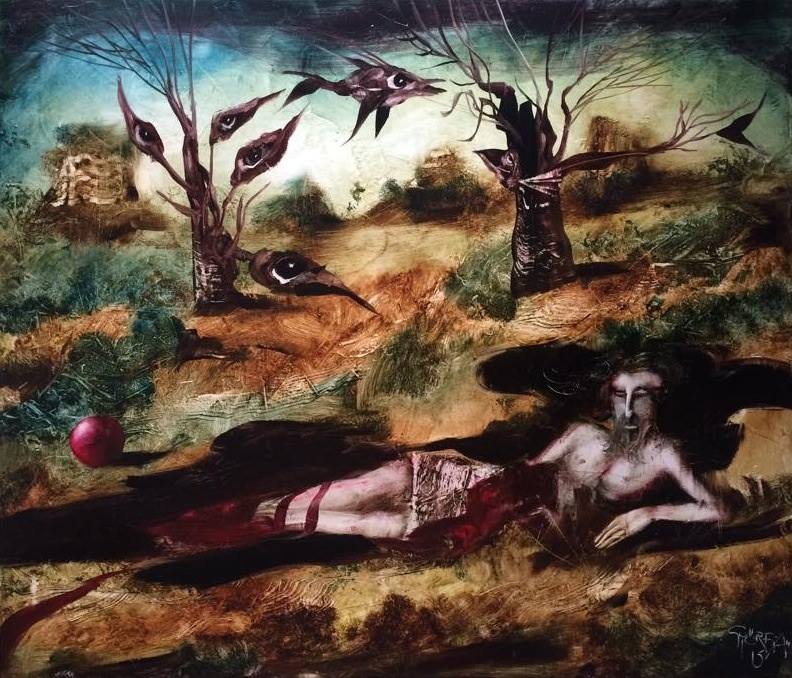ARTAMO GALLERY proudly presents the surreal-fantastic work of well-known Hungarian artist András Györfi with his first solo exhibition in the U.S. In his work, which shows a reminiscence to medieval tableaus with a witty or even satirical touch, the artist defends his personal paradise, his garden of Eden, his place to live and love, against foreign occupation, crusaders and intruders from the modern outside world. He lets the viewer dive into a different and strange new world of phantasy gardens with red spheres everywhere, turning him into Alice in Györfi’s wonderland.
ABOUT THE ARTIST AND HIS ART
András Györfi was born 1964 in the city of Kaposvár, Hungary. He started painting at a very young age as a student of the painters József Molnár and György Ruisz. When only nine years old he won the international design competition for children of Shankar in India competing with 5000 others.
His father and the internationally known Hungarian painter Endre Szász, who died a few years ago, were friends and the young artist spent much time in the famous painter’s studio watching him paint. This greatly formed Györfi’s artistic personality. He admired his master’s impulsive creativity, which perhaps influenced him the most. Over the years he developed his own unique style.
András Györfi moved to Budapest in 1981 where he studied and graduated with a degree in architecture. As a student he began illustrating for books and magazines, which he is still doing today. After graduating he worked as an architect for only one year. He yearned to be an artist and therefore devoted himself entirely to painting.
Györfi had his first exhibition in 1991 immediately gaining strong appreciation of his works. 1992 at an exhibition in his native city of Kaposvár Endre Szász introduced him as a talent of great promise, being very diligent and possessing all the characteristics needed to becoming one of the best. The same year at another exhibition in Budapest the visiting cultural director of the Hungarian Embassy in Washington was so impressed with Györfi’s work that he took three paintings to the American city for an exhibition. Later that year an invitation to exhibit in New York followed..
Györfi illustrated the stage of the Theatre of Sopron for a play by Raymond F. Simon and in London the stage of the opera Black Honey by Zsolt Pozsgai. He also worked in Aachen, Germany, and had exhibitions in various cities worldwide, including New York, Istanbul, London and Harbin in China. From 1994 to 1999 he was the director of the Polaris Art Gallery in Budapest. Since 1997 he is a member of the Art Symposium in Italy, Spain and Austria.
Many of Györfi’s paintings are allegorical portraits of himself being the central character, sitting in a bathtub, in a plane or on horseback. Apparently these are all different people but they always have the same face, the artist’s face with various expressions, various thoughts, a sort of Don Quixote, who wanders through his own reality and feels nostalgic for the past.
The most striking feature though are the red spheres appearing just about everywhere in his paintings; they are almost synonymous with the artist’s signature. These bright, red spheres always inspire the observer’s curiosity, wondering what they represent. The explanation lies in a game of words in Hungarian language in which “paradicsom” has a double meaning: “paradise” as well as “tomato”. Györfi’s spheres are stylized tomatoes symbolizing paradise and heaven, bringing happiness to his paintings. The number of the spheres and their position reflect the artist’s state of mind and level of happiness at the time the piece was painted. The spheres give insight into the interior gardens of his soul and the height of his positive feelings, yet they also stand for perfection — they are round and perfect, unlike the other imperfect and oddly shaped figures typically to be found in his works.
Györfi’s paintings are not caricatures, but are filled with elements of the grotesque. His paintings are a self-declared universe of mythical tales that enrich our lives. He looks at a world full of a surprise and is a great storyteller of the world’s wonders with his admiration for Salvador Dali shining through. His acidic sense of humor reminds occasionally of Hieronymus Bosch. The favorite landscape in his works is the Mediterranean.
Each of Györfi’s paintings is full of ideas, heaven and hell together, a supernatural miracle, like the ship that swims in the air and the horse on wheels. There is a chance to meet flying fish, knights of the past, in a scenario that may be in the deep sea or cuddled in clouds or any other place in the imagination. These paintings often invite us on a journey through time. Some strokes in his paintings show that the human being wants to be not only in civilization but in the world of fairytales as well. Most important of all remains his free creative – almost messy – imagination.
András Györfi is an artist in constant evolution towards the future with his heart beating simultaneously in the past and the present.
